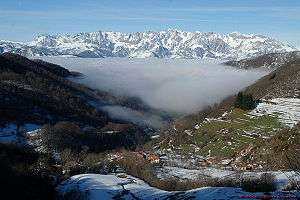Picos de Europa National Park
| Picos de Europa National Park | |
|---|---|
| Parque Nacional de Picos de Europa(Spanish) | |
|
IUCN category II (national park) | |
|
The Picos de Europa (view from Liébana). | |
| Location | Picos de Europa, Cantabrian Mountains, Spain |
| Nearest city | Cantabria: Santander |
| Coordinates | 43°11′51″N 4°51′06″W / 43.19750°N 4.85167°WCoordinates: 43°11′51″N 4°51′06″W / 43.19750°N 4.85167°W |
| Area | 646.60 km² |
| Established | 1918 |
| Governing body | Ministry of Environment of Spain |
The Picos de Europa National Park (Spanish: Parque Nacional de Picos de Europa) is a National Park in the Picos de Europa mountain range, in northern Spain. It is within the boundaries of three autonomous communities, Asturias, Cantabria and Castile and León, which are represented on the body which runs the park.
History
It was the first of the National Parks of Spain along with Ordesa y Monte Perdido National Park in the Pyrenees. When it was created 22 July 1918 it covered the western part of today's national park, centered on the Lakes of Covadonga. The Parque Nacional de la Montaña de Covadonga, as it then was called, had an area of 169.25 km². On May 30, 1995 the park was extended to include its current total area of 646.60 km².
On July 9, 2003 UNESCO approved Biosphere Reserve status for the National Park. Picos de Europa is one of several biosphere reserves in the Cantabrian Mountains which are being integrated into a single super-reserve to be known as "Gran Cantábrica". [1]
Geography
The total area of the park is 646.60 km² and is shared by Castilla y León, Asturias, and Cantabria. The highest point of the park is in Torre de Cerredo peak, 2,648 m AMSL and the lowest point is 75 m AMSL in the Deva River, that is, a vertical drop of 2,573 m.
The geological features of the park show the effects of glacial erosion on the limestone massifs that form the Cantabrian Mountains.
Flora and fauna
Several types of woods can be found in the area: trees include beeches and Cantabrian Holm Oaks.
The human population is about 1300. There are many protected animal species, like the Capercaillie, the Lammergeier (Gypaetus barbatus), the Cantabrian brown bear and the Iberian Wolf (Canis lupus signatus). The most representative animal of the Picos de Europa is the Pyrenean chamois (Rupicapra pyrenaica) or sarrio, or its more specific relative, the Cantabrian chamois (Rupicapra pyrenaica parva) or rebeco, of which there are many sculptures around the park, as well as the Spanish ibex (Capra pyrenaica).
See also
References
- ↑ Biosphere Reserve Information, accessed 2010, when the super-reserve was described as being built up "step by step".
External links
| Wikimedia Commons has media related to Picos de Europa National Park. |
- Official web of the Spanish Ministry of Environment
- Information and tourism office
- iberianature.com - English-language web site on nature in Spain and Portugal
